Saturday, February 28, 2004
Silvered Æ antoninianus, Antioch, Gallienus, Göbl 1631b

GALLIENVS AVG, Radiate draped cuirassed bust left | GENIO AVG, Genius standing facing, head left, holding cornucopia right, sacrificing from patera onto flaming tripod left. Branch in exergue.
I've been feeling a bit bummed out about a coin that's gone missing in the mail. It's a dealer that I've bought from before, he's doing all the right things to set the Postal hounds tracking, and I paid for insurance and know the actual loss will be minimal, but it's a shame when something nice is lost.
Then this arrived, and I had something to feel quite good about.
(I try to write these a day or two before posting, so that I always a couple posts ready to go and could slack off for a day without missing a post. As I write this, on Feb 26, the missing package, postmarked Jan 19, has arrived with a rumpled envelope and undamaged contents.)
Friday, February 27, 2004
Æ26, Kolophon in Ionia, Gallienus, SNG Cop 201
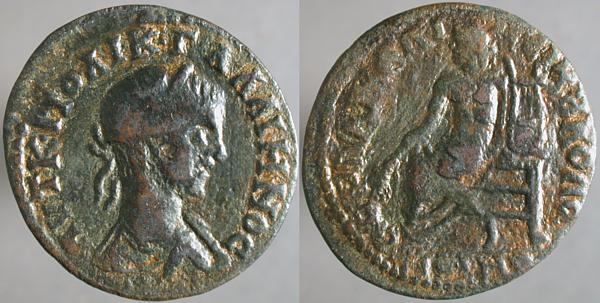
ΑVΤ Κ ΠΟ ΛΙΚ ΓΑΛΛΙΗΝΟC, Laureate draped cuirassed bust right | ΕΡΙ CΤΡ ΠΟ ΚΑΛΙΝΕΙΚΟV ΚΟΛΟΦ[...], Apollo seated left holding lyre right and laurel branch left.
A page of pictures of the aftermath of a 1999 earthquake in Degirmendere, on the site of Kolophon.
The bust is crudely executed, the reverse figure not much better, but the lettering's not bad for the times: the engraver was no artist, but I bet he was literate. That wasn't the case at all the provincial mints, I'll show a few egregious examples next week.
Thursday, February 26, 2004
Silvered Æ antoninianus, Antioch, Salonina, Göbl 1671l(2)
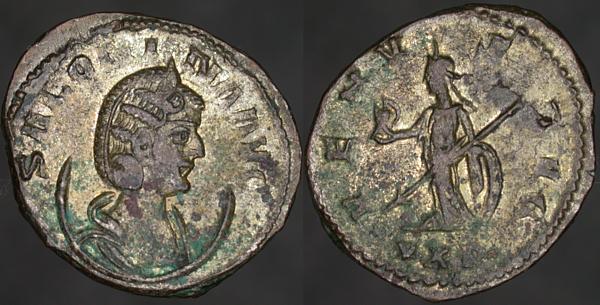
SALONINA AVG, Diademed draped bust right on crescent. | VENVS AVG, Venus standing facing, head left, holding helmet left and transverse spear, leaning on shield right. VXP in exergue.
A series of coins were struck in 266-267 at Antioch with PXV in the exergue, indicating that Gallienus was tribunicia potestas (an annual office) for the 15th time. On this example, the engraver reversed the position of those letters. I assume that there was just the one erroneous die and that all examples of this coin are from it. Göbl's book has a photo of one in the supplements section, presumably the American Numismatic Association example that he lists.
While I don't think that new collectors need rush to find a specialty, I only recognized this otherwise unremarkable coin as something special when I saw it on eBay because I do specialize.
Wednesday, February 25, 2004
Æ prutah, Judean Kingdom, Alexander Jannaeus, Sear Greek 6092
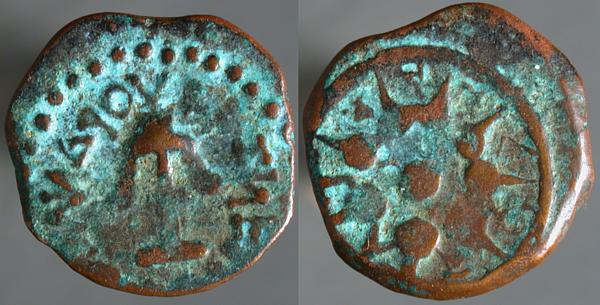
ΒΑΣΙΛΕΩΣ ΑΛΕΧΑΝΔΡΟΥ, Seleukid anchor | Wheel with 8 ray-like spokes. Hebrew letters in-between.
Jannaeus was a king of the Hasmonean dynasty, which was succeeded by Roman rule.
These common, crudely-made, coins, are frequently sold as "biblical widow's mites" though, as Jannaeus died in 76 BCE, his issues are unlikely to have still been in circulation during Jesus' time.
Update: Or perhaps they were still in circulation. The Hasmoneans churned out a lot of these things, which were far too valueless to hoard. (“a particularly ugly coin”).
Tuesday, February 24, 2004
Æ25, Erythrae in Ionia, quasi-autonomous, SNG von Aulock 1973
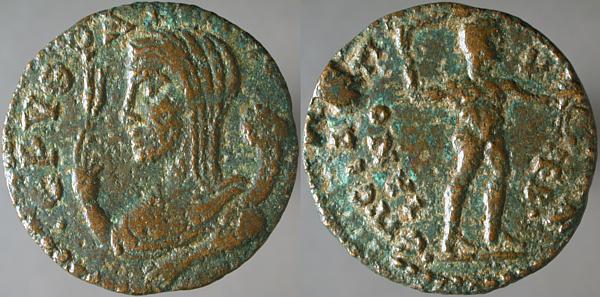
·ΕΡVΘΡΑ[ΩΝ], Veiled bust of Demeter left, holding grain ears left and cornucopiae right | ·ΕΡ·CΤ Α[ΙΛ] Π[Α ΔΙΟΓΕΝ]ΙΑΝΟ Τ·Β·, Herakles standing right, brandishing club behind head and lion's skin right.
Minted circa the reign of Gallienus.
An interesting page about Erythrae, now ruins with "free admission, but the caretaker may ask for something."
Monday, February 23, 2004
Billon antoninianus, Samosata, Valerian, Göbl 1677e
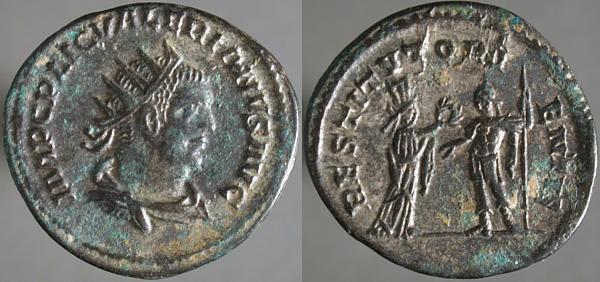
IMP C P LIC VALERIANVS AVG, Radiate draped cuirassed bust right | RESTITVT ORIENTIS, Tyche, left, presenting wreath to emperor, right, who holds spear right.
The restorer of the East. Hubris, and counting unhatched chickens.
Sunday, February 22, 2004
Æ20, Ephesus in Ionia, Saloninus, unknown
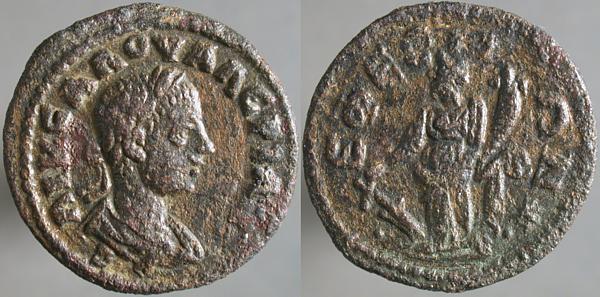
ΛΙΚ CΑΛ ΟVΑΛΕΡΙΑΝ[Ο]_C, Laureate draped bust right | ·ΕΦΕC_Ι_ΩΝ·, Tyche standing facing, head left, holding cornucopia right and rudder left. Star in lower right field.
Ephesus also minted the commonest Roman provincial reverse in this period, Tyche with cornucopia and rudder. This coin of Saloninus, the elder son of Gallienus, isn't documented in any catalog I own, but that's never definitive in provincial coins: there are always more catalogs. A series of books intended to be more nearly comprehensive than any before is being published, but to date it's only reached 96 CE, and Gallienus and family are nearly 160 years after that.

